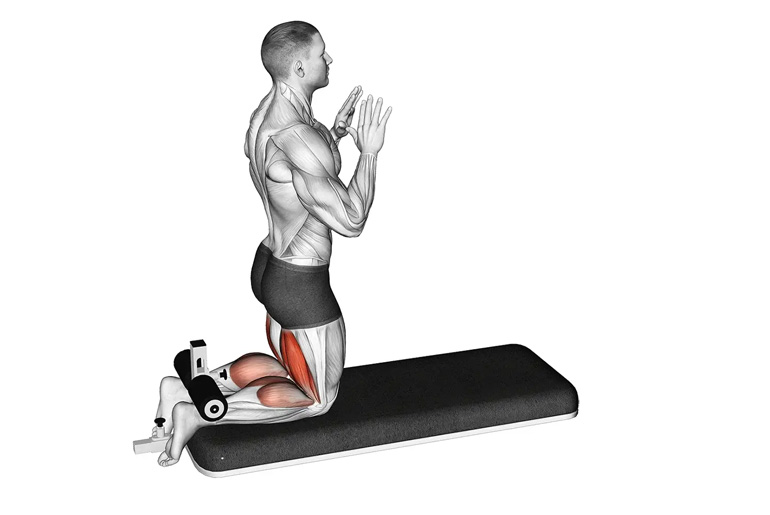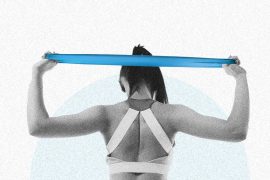Nordic curls are a challenging exercise targeting the hamstrings, glutes, and lower back. Unlike traditional hamstring exercises, Nordic curls emphasize eccentric muscle contraction, where muscles lengthen under tension. This exercise involves kneeling on a soft surface, lowering the torso forward while keeping the back straight, and then using hamstring strength to control the descent until the body is parallel to the ground.
Nordic curls improve hamstring strength, flexibility, and stability, making them valuable for athletes and fitness enthusiasts seeking to enhance lower body performance and reduce injury risk. Integrating Nordic curls into a workout routine can contribute to balanced muscle development and overall fitness.
Benefits of Nordic Curls:
Nordic curls offer several benefits, making them a valuable addition to any fitness routine, especially for those focusing on lower body strength and stability:
- Hamstring Strength: Nordic curls primarily target the hamstrings, helping to build strength and endurance in these muscles. This is crucial for activities like running, jumping, and maintaining overall leg strength.
- Balance in Muscle Development: They provide a counterbalance to exercises that often emphasize the quadriceps, such as squats and lunges. This helps in achieving a more balanced lower body strength.
- Core Activation: Performing Nordic curls requires significant core engagement to maintain proper posture and control throughout the movement. This helps strengthen the core muscles, improving overall stability and posture.
- Injury Prevention: Strong hamstrings play a key role in preventing injuries, particularly in the knees and lower back. By strengthening the hamstrings through exercises like Nordic curls, individuals can reduce the risk of strains and other related injuries.
- Functional Fitness: Nordic curls mimic natural movement patterns, making them beneficial for enhancing functional fitness. They improve the body’s ability to perform everyday activities that involve bending at the hips and knees.
- Scalability: Nordic curls can be adapted to various fitness levels by adjusting the level of assistance (using bands or partners) or progressing to more challenging variations as strength improves.
Overall, incorporating Nordic curls into a workout regimen can contribute to improved lower body strength, injury prevention, and enhanced overall fitness and stability.
How to Practice Nordic Curls:
Practicing Nordic curls requires proper technique and progression to ensure effectiveness and safety. Here’s a step-by-step guide on how to perform Nordic curls:
Setup:
- Kneeling Position: Begin by kneeling on a soft surface, such as a yoga mat or padded floor. Your partner can hold your ankles, or you can anchor them securely under a sturdy object.
- Body Position: Keep your torso straight and aligned from knees to head throughout the exercise. Engage your core to maintain stability.
Execution:
3. Lowering Phase:
Slowly lean forward from your knees while maintaining a straight line from your knees to your head. Control the descent primarily using your hamstrings.
Aim to lower your upper body towards the ground in a controlled manner. Avoid letting your hips drop or arching your back excessively.
4. Assistance: Use your hands or assistance from a partner if needed to control the descent and prevent any sudden drops that could strain your muscles.
5. Return Phase:
- Once you’ve reached the point where you can no longer control the descent, use your hands or assistance to push yourself back up to the starting position.
- Engage your hamstrings and glutes to lift your body back to the kneeling position while maintaining stability.
Progression Tips:
6. Assisted Nordic Curls: Start with assisted variations using resistance bands or a partner holding your ankles to provide support as you lower and lift your body.
7. Unassisted Nordic Curls: Gradually reduce the amount of assistance over time until you can perform the exercise without assistance, relying solely on your hamstrings and core strength.
8. Variations: As you become stronger, you can increase the challenge by extending your arms forward or holding weights to add resistance.
Safety Precautions:
- Start Slowly: Begin with a few repetitions and gradually increase as your strength improves.
- Maintain Control: Focus on controlled movements throughout the exercise to avoid straining muscles or causing injury.
- Listen to Your Body: If you experience discomfort or pain, stop immediately and reassess your technique or seek guidance from a fitness trainer.
By practicing Nordic curls with proper technique and gradually progressing in difficulty, you can effectively strengthen your hamstrings, improve lower body stability, and enhance overall functional fitness.
Who Should Avoid Nordic Curls:
Nordic curls are a challenging exercise that may not be suitable for everyone, especially those with certain conditions or fitness levels. Here are groups of people who should consider avoiding or approaching Nordic curls with caution:
- Beginners: Individuals who are new to strength training or have limited experience with lower body exercises may find Nordic curls too demanding initially. It’s advisable to start with simpler hamstring exercises and gradually build strength before attempting Nordic curls.
- Individuals with Knee Issues: Nordic curls put significant stress on the knee joints, particularly during the lowering phase. Those with knee pain, instability, or a history of knee injuries should consult a healthcare professional or physical therapist before attempting Nordic curls. Proper form and progression are crucial to prevent exacerbating knee problems.
- Hamstring Strain or Injury: If you have a current or recent hamstring strain or injury, Nordic curls may aggravate the condition. It’s essential to allow adequate healing time and focus on rehabilitation exercises recommended by a healthcare provider before incorporating Nordic curls into your routine.
- Limited Core Strength: Proper execution of Nordic curls requires strong core engagement to maintain stability and prevent injury. Individuals with weak core muscles may struggle to maintain proper form throughout the exercise, increasing the risk of strain or discomfort.
- Pregnant Women: Pregnant women should avoid exercises that put excessive pressure on the abdomen or pelvis. Nordic curls involve bending at the hips and knees, which may not be suitable during pregnancy due to changes in center of gravity and increased risk of injury.
- Elderly Individuals: Older adults, particularly those with reduced joint mobility or stability, may find Nordic curls too challenging and potentially risky. It’s essential to choose exercises that are safer and more appropriate for maintaining strength and mobility without undue strain.
- Anyone with Lower Back Issues: Nordic curls require bending at the hips and maintaining a straight spine, which can strain the lower back if not performed correctly. Individuals with chronic lower back pain or spinal conditions should proceed cautiously and consider alternatives that place less stress on the lumbar spine.
Before starting any new exercise program, especially one as demanding as Nordic curls, it’s crucial to consult with a qualified fitness professional or healthcare provider to assess suitability and receive personalized guidance based on individual health and fitness considerations.
Additional Tips:
- Warm-up: Always warm up your muscles before starting Nordic curls to reduce the risk of injury.
- Form: Focus on maintaining proper form throughout the exercise to maximize effectiveness and safety.
- Frequency: Incorporate Nordic curls into your midweek routine 1-2 times per week, allowing adequate recovery between sessions.
Nordic curls offer a challenging yet rewarding workout for improving hamstring strength and overall lower body stability, making them a valuable addition to any fitness regimen, particularly midweek when targeting specific muscle groups can aid overall balance and strength development.
Disclaimer:
The information contained in this article is for educational and informational purposes only and is not intended as a health advice. We would ask you to consult a qualified professional or medical expert to gain additional knowledge before you choose to consume any product or perform any exercise.








